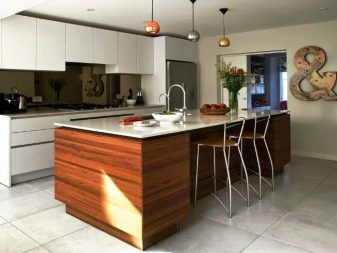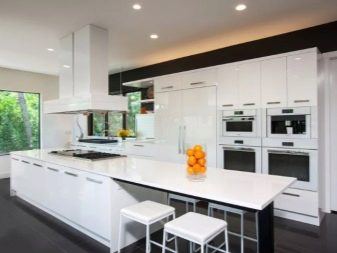Island kitchens are now popular in a variety of interiors - they are very diverse and are well suited for both small and spacious kitchen rooms. Sometimes it is not easy to determine the size of the island. This problem is faced by many people who decide to work on the design of the kitchen on their own. In this article we will consider possible solutions to this issue.


Shapes and sizes
Kitchen islands are quite diverse and varied. Designers often recommend placing the island only on an area of more than 18 square meters. m however, everything will depend on the specific layout and the specific island - some miniature models can easily be placed even in the kitchen of 8 square meters. m


The design and dimensions are decisive for the size of the island. The standard models of the kitchen island are considered options in which the size of the countertop is 180x90 or 120x120 cm and the height from the floor is approximately equal to a meter. However, the options are different - the smallest islands are made with a tabletop 120x90, and the minimum height can be 85 cm. And, of course, the island can be much larger if the place allows you.
In addition, sometimes the kitchen island is connected by a bar with seats - in this case, the sizes can be almost any.


To determine the size of the required kitchen island, pay attention to the following points.
- The dimensions of your premises are of utmost importance. So that the island does not clutter up the entire space of the room, it must be correctly entered - it is better not to put a large island in a small kitchen, since it will occupy too much space.
- Proceed directly from your needs - furniture in the kitchen in the first place should be as functional as possible. You may need an island if there is not enough space for cooking on the main headset, if you want to separately place the equipment or have an additional table and kitchen cabinets. It is important to build on the goals - if, for example, you want to place several units of household appliances on the island, it must definitely be rather big.
- Keep in mind that even islands of the same size can occupy different spaces, look different, be comfortable or not - it depends on the ratio of width and height. For example, in a small square kitchen it would be wise to put a narrow island along one of the walls, and islands with equal sides, regardless of size, are more suitable for a large kitchen.




Shape is by no means less important than the size of the island. It serves practical purposes, helps to more comfortably furnish the room, and can also become a designer highlight, because modern possibilities of furniture design are extremely rich and diverse.
- Rectangular shape meets most often. This is a convenient option for different types of furnishings - you can use such an island in any interior style. Under the rectangular island, you can successfully place both cabinets and built-in appliances. This is a universal model in its functionality. Also often such an island goes into a bar.
- Square the island can also look very interesting. Most often they put it in spacious kitchens, but in a small one it can fit well if the space has it. Such an island can be interestingly zoned, and you can use it as you like.
- In modern kitchens are often found round islets - They fell in love with many due to the lack of sharp corners. This is especially true for a fairly small kitchen, where the passage between the headset and the island is small - indeed, you can easily hit it. The round island looks harmonious, often it is used to place a sink or an additional countertop with cabinets. Also, several armchairs can be placed near it - such an island will replace the bar counter.
- There are other bizarre design forms of kitchen islands. For example, it can be triangular, wavy, consist of several circles or polygons. Such decorative islands are recommended to be used only in spacious kitchens - they originally complement the overall design in modern styles, but they are not always as convenient as possible.
Often, these islands take up a lot of extra space, complicate the passage along the aisle and are not suitable for accommodating household appliances. Consider these features before buying.




Distance to other furniture
The dimensions and shape of the kitchen island themselves are significant in comparison with other furniture and the overall layout of the space. You can put a kitchen island in different ways, but it is always important to think about the convenience of its use and the passage through the room. In different cases minimum distance will be different.


Often an island is placed in the kitchen opposite - it is this arrangement that is considered standard and is used most often. If you are making an island with a countertop or a sink, the distance from the headset should be 70-90 cm: so it will be convenient for you right in the process of cooking to turn around to it if you need to wash or cut something.
If the island is needed for placing cabinets or as an additional table, it would be wise to make a greater distance - at least 1 meter. Finally, if you are planning to place household appliances under the island's countertop, the distance should be even greater so that, for example, the heat from the oven does not damage the surface of the headset, and also make it convenient for you to bend down to work with appliances. Ideally, the distance should be 120-150 cm.

If the island is located at an angle to the kitchen and rests on the wall, the distance can be almost any - here only practical considerations are important. Keep in mind that often the place between such an island and the headset is wasted - it would be nice to take it by placing an armchair, wall shelf or any other furniture that is convenient for you. If the island does not lean against the wall at an angle to the kitchen, you need to place it carefully - with its chaotic location, it can simply interfere with movement around the room. therefore it should be located as logical as possible.
Well, if the headset and the island in their environment will form the correct geometric shape - a rectangle or triangle. Designers often use this technique to arrange furniture beautifully and conveniently.

Sometimes a kitchen island is by no means adjacent to a kitchen set - for example, if it goes to the bar, armchairs or other seats are often placed next to it. Depending on the layout, the seats can be turned both to the headset and in opposite directions. If you need to furnish a living room or studio, it will be logical to put chairs between the island and the headset, to better zone the room, however, in this case, the distance between the headset and the island should be about 3 meters.


How to determine the dimensions?
Modern interior designers pay more and more attention not only to aesthetics and style, but also to practicality, convenience and ergonomics. Ergonomics is a science about the interaction of a person and objects surrounding him, it allows you to arrange furniture so that it is comfortable to be in space. You have to find the optimal size of the kitchen island. If you are considering various layout options, it would be wise to outline all possible solutions.

An island in a small and medium kitchen should be extremely convenient and useful - if you do not need an extra countertop, cabinets or a place for equipment, it is better not to put it at all. In other cases, you need to decide what size cabinet or built-in appliances you need, and proceed from this.
Also think about how to use the island as efficiently as possible - for example, you can store some dishes or equipment on it even from above, and it itself can serve as a partition in a large room.


Often, designers choose miniature islands if they need to be placed against the wall, and the functional purpose is an extra place for cooking. Large ones can become both the semantic center of the kitchen and serve for zoning.
Often islands with decorative fireplaces make islands in spacious rooms - this can be realized even with standard dimensions. The most difficult thing is with the islands of irregular shape, which serve decorative purposes. They should not be too large, otherwise the whole space of the kitchen around them will not be too convenient for cooking and eating.


You can find out how useful a kitchen island can be from the video below.










